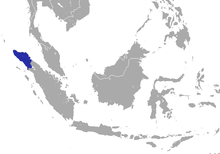Thomas Langur
| Thomas Langur | ||||||||||||
|---|---|---|---|---|---|---|---|---|---|---|---|---|

Thomas Langur ( Presbytis thomasi ) |
||||||||||||
| Systematics | ||||||||||||
|
||||||||||||
| Scientific name | ||||||||||||
| Presbytis thomasi | ||||||||||||
| ( Collett , 1893) |
The Thomas Langur ( Presbytis thomasi ) is a species of primate from the group of the Schlankaffen (Presbytini).
features
Like all boned langurs, Thomas langurs are relatively small, slender primates with long hind legs and a tail that is longer than the body. The average weight is 6.7 kilograms, there is hardly any gender dimorphism . Their fur is gray-black on the back and on the outside of the limbs and whitish on the belly and on the inside of the limbs. The head is striking: from the tip of the head of hair, two white stripes extend in a V-shape to the eyes. The orange-brown eyes are surrounded by silver-colored, white-rimmed circles.
distribution and habitat
Thomas langurs live in the province of Aceh in the north of the Indonesian island of Sumatra . Their habitat is forests, but they can also be found in rubber plantations.
Way of life
These primates are mainly found in the trees, but sometimes they come to the ground to forage. They are diurnal, but have their activity peaks in the morning and afternoon and stop at noon. In the trees they move either on four legs or by jumping.
They live in groups of 3 to 21 animals. These are harem groups, i.e. a group usually consists of a male, several females and their offspring; the remaining males often form bachelor groups. The females establish a hierarchy that is particularly evident when there is little food available. If a new male takes over a harem group, infanticide often occurs , which means that the male kills the children conceived by his predecessor in order to be able to conceive offspring with the females. Sometimes the females avoid this by leaving their group in the event of a takeover. In general, it seems to be relatively frequent that females leave their group, also in order not to let groups become too large.
The groups are territorial, but the ranges of the groups overlap. Encounters between two groups are often aggressive, with loud shouting and, if necessary, fistfighting, they try to drive away the opponent.
food
Thomas langurs are mainly herbivores, with young leaves and fruits making up the majority. In addition, they also consume flowers, seeds and other parts of plants. They come to the ground to eat mushrooms, fallen fruit, small animals such as insects and snails, and sometimes earth.
Reproduction
There is no fixed mating season. After a five to six month gestation period, the female gives birth to a single young. This initially has a white fur. It is weaned after 12 to 15 months and sexually mature at 4 to 5 years. The males and often the females leave their birth group at this point.
threat
The main threats to the Thomas langur are habitat destruction and hunting. Compared to other Southeast Asian primates, however, it is still relatively common and the IUCN lists it as a low risk.
literature
- Thomas Geissmann : Comparative Primatology. Springer-Verlag, Berlin et al. 2003, ISBN 3-540-43645-6 .
Web links
- Presbytis thomasi in the endangered Red List species the IUCN 2006. Posted by: A. Eudey & Members of the Primate Specialist Group, 2000. Accessed on 7 April of 2008.
- Information on Theprimata.com
- Information on Animal Diversity Web
